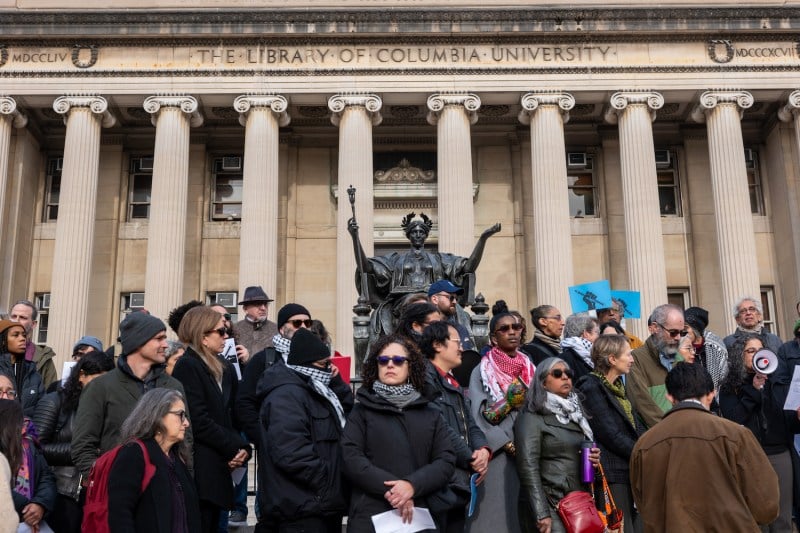Can Universities Use Their Fortunes to Fight Trump?

Can Universities Use Their Fortunes to Fight Trump?
The president is targeting institutions with hefty endowments—and betting they won’t resist.
Members of Columbia University’s faculty hold a protest in support of Palestinians and free speech, seen on the university’s campus in New York City on Nov. 15, 2023. Spencer Platt/Getty Images
Emboldened by Columbia University’s recent capitulation to a series of sweeping government demands, U.S. President Donald Trump is weaponizing vast sums of federal funding against a growing number of universities.
As of Friday morning, the Trump administration has now either frozen, canceled, or threatened more than hundreds of millions of dollars in federal funding to seven wealthy universities: Columbia, the University of Pennsylvania, Princeton, Harvard, Brown, Cornell, and Northwestern. To justify the moves, Trump officials have cited the universities’ policies for transgender athletes and alleged antisemitism and racial discrimination.
Emboldened by Columbia University’s recent capitulation to a series of sweeping government demands, U.S. President Donald Trump is weaponizing vast sums of federal funding against a growing number of universities.
As of Friday morning, the Trump administration has now either frozen, canceled, or threatened more than hundreds of millions of dollars in federal funding to seven wealthy universities: Columbia, the University of Pennsylvania, Princeton, Harvard, Brown, Cornell, and Northwestern. To justify the moves, Trump officials have cited the universities’ policies for transgender athletes and alleged antisemitism and racial discrimination.
With Columbia, Trump wielded $400 million in canceled federal funding to pressure administrators into surrendering to a raft of far-reaching government demands, and he is now reportedly considering pushing for federal oversight of the university. Trump now appears to be using that same playbook with the other institutions, most recently by issuing a long list of “critical reforms” to Harvard that the university must meet to continue receiving federal funding.
The moves amount to an unmistakable incursion on academic freedom as Trump seeks to expel what he has called “anti-American insanity” from universities and reclaim “our once-great educational institutions from the radical left.” More could soon come, too. The Trump administration is investigating more than 50 institutions for alleged racial discrimination—an accusation that largely targets efforts by universities to promote diversity—and previously warned 60 universities of potential punishment from antisemitism probes.
Yet the ongoing campaign has sparked confusion about why institutions such as Columbia—which ranks among the world’s richest universities—aren’t using their fortunes to fight back. Columbia, for example, touts a nearly $15 billion endowment, assets that could theoretically cushion the blow of $400 million in pulled federal funding. Harvard has a whopping endowment of more than $50 billion.
“Outsiders look at the dollar amounts and say, ‘You know, that’s a ton of money available, right? Why don’t they step up?” said Todd Ely, a professor at the University of Colorado Denver. “But the story gets a lot more complicated when you start digging into what endowments are.”
Endowments are, at the most basic level, pools made up of various separate funds that are crucial to powering universities’ ongoing and future operations—whether that’s by supporting financial aid, study abroad programs, or research efforts—and also underpin the institutions’ long-term business strategies.
It’s “really this collection of assets the colleges and universities invest, and the idea is they’ll be generating a long-term stream of revenue,” Ely said.
Since many donors have earmarked their contributions for certain purposes, there are indeed constraints on endowment spending, experts said. Phillip Levine, an economics professor at Wellesley College, said that donations often come with “strings attached” to them.
“The endowment is not a piggy bank,” Levine said.
Still, there is some room to maneuver. Much of the endowments’ restricted funding relates to operations that universities would spend money on anyway—such as financial aid or operating libraries—and even then, not all of the universities’ funding is legally bound, said Morton Schapiro, a former president of both Northwestern University and Williams College. While universities typically spend around 5 percent of their endowment per year, they have historically spent more in times of hardship, such as during the 2008 financial crisis.
“There’s more flexibility on spending the endowment than most presidents admit,” Schapiro said.
Yet even with that flexibility, by dangling hundreds of millions of dollars in federal funding over these universities, the Trump administration is forcing administrators to confront difficult trade-offs that will only become more existential over time.
In an interview with NPR, Christopher Eisgruber—the president of Princeton University and one of the most vocal critics of Trump’s crackdown on higher education—said that the university’s $34.1 billion endowment can help it respond to “very short-term suspensions in research funding.”
“But if you get to longer-term deprivation of grants at Princeton or elsewhere, what it’s going to mean is that there are going to have to be choices to stop doing things that we’re doing now,” he added.
The big question now is whether Trump’s latest targets will follow in Columbia’s footsteps. As Trump sets his sights on more universities, a growing chorus of voices, including Eisgruber, has urged the wealthy institutions to fight back.
One such voice is Larry Summers, the former president of Harvard University as well as a former secretary of the U.S. Treasury Department, who warned in a New York Times op-ed last week that Trump’s threats “must be resisted using all available legal means”—including the institutions’ endowments.
“Part of their function is to be drawn down in the face of emergencies, and covering federal funding lapses surely counts as one,” he wrote. “Believe me … when I say that ways can be found in an emergency to deploy even parts of the endowment that have been earmarked by their donors for other uses.”
Trump’s pressure campaign is just one part of his sweeping effort to remake higher education in the country. On top of the president’s funding threats, universities across the United States have also been roiled by the administration’s purge of the National Institutes of Health. Republican lawmakers are also mulling further hiking up the tax rate on top university endowments—measures that would only add pressure on many of these institutions’ finances.
All of this turbulence also comes as the Trump administration has launched a sweeping crackdown on students who participated in or are in any way associated with pro-Palestinian activism. Trump has sought to deport foreign-born students who are in the United States legally—in many cases, seemingly over their support for the Palestinian cause—and his administration has revoked more than 600 student visas.
“There’s just these huge forces that are bearing down on these institutions, all of which are troublesome one at a time, and collectively, they are overwhelming,” said Levine, of Wellesley College.
Christina Lu is an energy and environment reporter at Foreign Policy. X: @christinafei
More from Foreign Policy
-

American flags are draped around tables and pipes in a small factory room as women work at sewing machines to produce them. Tariffs Can Actually Work—if Only Trump Understood How
Smart trade policy could help restore jobs, but the president’s carpet-bomb approach portends disaster.
-

Donald Trump looks up as he sits beside China’s President Xi Jinping during a tour of the Forbidden City in Beijing on Nov. 8, 2017. Asia Is Getting Dangerously Unbalanced
The Trump administration continues to create headlines, but the real story may be elsewhere.
-

Trump announces tariffs Trump’s Wanton Tariffs Will Shatter the World Economy
Economic warfare is also a test for U.S. democracy.
-

The Department of Education building in Washington, DC on March 24. Why Republicans Hate the Education Department
Broad popular support means that even Ronald Reagan failed at dismantling the agency.






![A person holds up a sign at a protest that reads: "Keep Your [picture of hands] OFF The Students"](https://foreignpolicy.com/wp-content/uploads/2025/03/Columbia-protests-GettyImages-2204533603.jpg?w=800?quality=80)




Join the Conversation
Commenting on this and other recent articles is just one benefit of a Foreign Policy subscription.
Already a subscriber?
.
Subscribe
Subscribe
View Comments
Join the Conversation
Join the conversation on this and other recent Foreign Policy articles when you subscribe now.
Subscribe
Subscribe
Not your account?
View Comments
Join the Conversation
Please follow our comment guidelines, stay on topic, and be civil, courteous, and respectful of others’ beliefs.
Change your username |
Log out
Change your username:
CANCEL
Confirm your username to get started.
The default username below has been generated using the first name and last initial on your FP subscriber account. Usernames may be updated at any time and must not contain inappropriate or offensive language.